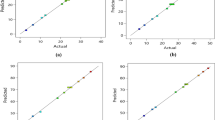Abstract
Quinolizidine alkaloids are the main bioactive components in Sophora alopecuroides L. This study reports a novel ultrasound-assisted enzymatic hydrolysis method for the extraction of these important alkaloids. Box–Behnken design, a widely used response surface methodology, was used to investigate the effects of process variables on ultrasound bath-assisted enzymatic hydrolysis (UAEH) extraction. Four independent variables, pH, extraction temperature (°C), extraction time (min) and solvent-to-material ratio (mL/g), were studied. For the extraction of sophocarpine, oxysophocarpine, oxymatrine, matrine, sophoramine, sophoridine and cytisine, the optimal UAEH condition was found to be a pH of 5, extraction temperature of 54 °C, extraction time of 60 min and solvent-to-material ratio of 112 mL/g. The experimental values obtained under optimal conditions were fairly consistent with the predicted values. UAEH extraction was then compared with reflux heating, enzymatic extraction and ultrasound-assisted extraction. Of these extraction methods, UAEH extraction under optimal conditions produced the highest yield for seven types of alkaloids. In addition, UAEH extraction resulted in lower ingredient degradation than reflux heating extraction.



Similar content being viewed by others
References
Miao Y, Wu B, Zhang W, Qiu Y, Li B, Lu X (2011) Neuroprotective effect of sophocarpine against transient focal cerebral ischemia via down-regulation of the acid-sensing ion channel 1 in rats. Brain Res 1382:245–251
Liu H, Sun Y, Gao Y, Chen F, Xu M, Liu Z (2010) The analgesic effect and mechanism of the combination of sodium ferulate and oxymatrine. Neurochem Res 35:1368–1375
Ao C, Araki N, Tawata S (2009) Cyclooxygenase inhibitory compounds with antioxidant activities from sophora subprostrata. Chem Asian J 21:745–754
Li X, Zhou R, Zheng P, Yan L, Wu Y, Xiao X, Dai G (2010) Cardioprotective effect of matrine on isoproterenol-induced cardiotoxicity in rats. J Pharm Pharmacol 62:514–520
Yu Y, Ding P, Chen D (2004) Determination of quinolizidine alkaloids in Sophora medicinal plants by capillary electrophoresis. Anal Chim Acta 523:15–20
Jiang H, Hou C, Zhang S, Xie H, Zhou W, Jin Q, Cheng X, Qian R, Zhang X (2007) Matrine upregulates the cell cycle protein E2F-1 and triggers apoptosis via the mitochondrial pathway in K562 cells. Eur J Pharmacol 559:98–108
Zhang S, Qi J, Sun L, Cheng B, Pan S, Zhou M, Sun X (2009) Matrine induces programmed cell death and regulates expression of relevant genes based on PCR array analysis in C6 glioma cells. Mol Biol Rep 36:791–799
Wang Y, Zhao W, Xue R, Zhou Z, Liu F, Han Y, Ren G, Peng Z, Cen S, Chen H, Li Y, Jiang J (2011) Oxymatrine inhibits hepatitis B infection with an advantage of overcoming drug-resistance. Antivir Res 89:227–231
Akdeniz D, Özmen A (2011) Antimitotic effects of the biopesticide oxymatrine. Caryologia 64:117–120
Wang H, Guo S, Qian D, Qian Y, Duan J (2012) Comparative analysis of quinolizidine alkaloids from different parts of Sophora alopecuroides seeds by UPLC–MS/MS. J Pharm Biomed Anal 67–68:16–21
Pan G, Li F, Li J (2008) Effect of converter of matrine and oxymatrine on extraction method of Radix Sophorae flavescentis. Res Pract Chin Med 22:52–54
Schaber P, Berchou K, Wierchowski EE (2005) Introducing analytical biochemistry across the curriculum using supercritical fluid extraction (SFE) and the case study approach: to SFE or not to SFE, extraction of caffeine (an alkaloid) from tea leaves. Abstr Pap Am Chem Soc 229:U465–U466
Yuan Z, Xiao X, Li G (2013) Dynamic pH junction high-speed counter-current chromatography coupled with microwave-assisted extraction for online separation and purification of alkaloids from Stephania cepharantha. J Chromatogr A 1317:203–210
Teng H, Choi Y (2013) Optimization of microwave-assisted extraction of bioactive alkaloid compounds from Rhizoma coptidis (Coptis chinensis Franch.). Food Sci Biotechnol 22:1293–1300
Helman J (1969) Effects of some enzymes, surface-active agents, and calcium chloride on the aqueous extraction of alkaloids from belladonna leaves. J Pharm Sci 58:1085–1088
Teng H, Choi Y (2014) Optimization of ultrasonic-assisted extraction of bioactive alkaloid compounds from Rhizoma coptidis (Coptis chinensis Franch.) using response surface methodology. Food Chem 142:299–305
Wang W, Yu H, Sha Y (1982) Structure analysis of polysaccharide from Sophora alopecuroides Linn. Chin J Anal Chem 10:666–672
Choudhari S, Ananthanarayan L (2007) Enzyme aided extraction of lycopene from tomato tissues. Food Chem 102:77–81
Tan Y, Marshall W (1997) Enzymic digestion–high-pressure homogenization prior to slurry introduction electrothermal atomic absorption spectrometry for the determination of selenium in plant and animal tissues. Analyst 122:13–18
Framil M, Pineiro A, Barrera P (2007) Improvements on enzymatic hydrolysis of human hair for illicit drug determination by gas chromatography/mass spectrometry. Anal Chem 79:8564–8570
Konwarh R, Pramanik S, Kalita D, Mahanta C, Karak N (2012) Ultrasonication—a complementary ‘green chemistry’ tool to biocatalysis: a laboratory-scale study of lycopene extraction. Ultrason Sonochem 19:292–299
Dong L, Fu Y, Zu Y, Luo M, Wang W, Li X, Li J (2012) Application of cavitation system to accelerate the endogenous enzymatic hydrolysis of baicalin and wogonoside in Radix Scutellariae. Food Chem 131:1422–1429
Prasad K, Hassan F, Yang B, Kong K, Ramanan R, Azlan A, Ismail A (2011) Response surface optimisation for the extraction of phenolic compounds and antioxidant capacities of underutilized Mangifera pajang Kosterm. peels. Food Chem 128:1121–1127
Acknowledgements
This work was supported by the National Natural Science Foundation of China (no. 81460645, no. 81603227), and the Special Talents Foundation of Ningxia Medical University (no. XT201408).
Author information
Authors and Affiliations
Corresponding author
Ethics declarations
Conflict of interest
The authors have no conflicts of interest to declare.
Electronic supplementary material
Below is the link to the electronic supplementary material.
Rights and permissions
About this article
Cite this article
Wang, H., Tong, Y., Li, W. et al. Enhanced ultrasound-assisted enzymatic hydrolysis extraction of quinolizidine alkaloids from Sophora alopecuroides L. seeds. J Nat Med 72, 424–432 (2018). https://doi.org/10.1007/s11418-017-1165-7
Received:
Accepted:
Published:
Issue Date:
DOI: https://doi.org/10.1007/s11418-017-1165-7




